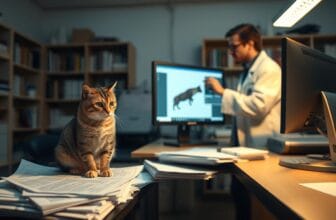
Table of Contents
Ever wondered how your cat finds its way home from far away? Or remembers where a hidden treat is months later? The amazing cat spatial memory shows us a world of feline smarts that surprises us.
Cats can navigate and remember places with amazing detail. Their ability to find their way is not just instinct. It’s a complex brain process that has grown over thousands of years. This skill helps them survive, hunt, and live well in different places.
Watching your cat move with ease in your home or outdoors is amazing. They use a special way to map their surroundings. They remember every corner, hiding spot, and path with incredible accuracy.
Cats can find their way in cities or suburbs with ease. Their ability to navigate shows their brain’s power. It’s a sign of their ability to adapt and think deeply.
In this look at cat spatial memory, we’ll explore the science behind their amazing skills. You’ll see your cat in a new light.
Understanding the Feline Brain Structure
Cats have a complex brain that lets them move around with great skill. Their brain is made up of many neural networks. These networks help them remember places and solve problems.
Exploring feline neuroscience shows how cats remember and understand their surroundings. Their brain’s design lets them create mental maps and make fast decisions.
The Role of the Cerebral Cortex
The feline cerebral cortex is key for complex thinking. It helps cats:
- Process sensory information
- Make quick decisions
- Solve problem-solving challenges
- Interpret environmental cues
The Hippocampus and Memory Formation
The cat hippocampus is vital for spatial memory. It works like an internal GPS. It helps cats:
- Create detailed mental maps
- Remember important locations
- Recall navigation routes
- Store long-term spatial memories
Neural Pathways for Navigation
Cats have special neural pathways for navigation. These pathways connect different brain areas. They allow for smooth information flow.
| Brain Region | Primary Function | Navigation Impact |
|---|---|---|
| Cerebral Cortex | Complex thinking | Strategic route planning |
| Hippocampus | Memory storage | Spatial memory mapping |
| Temporal Lobe | Sensory integration | Environmental perception |
Learning about these brain structures helps us understand how cats navigate so well.
How Cats Process Environmental Information
Cats are experts at understanding their surroundings. They use many senses to read their environment. Their senses are much better than ours, helping them move and understand their world with great skill.
They process their environment through a complex system of senses. Their sharp senses give them a full picture of their surroundings. This lets them spot even the smallest changes.
- Hearing: Cats can hear sounds up to 64 kHz, much higher than humans.
- Vision: Their eyes are super sensitive to movement, especially in the dark.
- Smell: Their noses pick up on detailed smells, giving them a lot of information.
- Whiskers: These help them feel their space and sense air movements.
Every sense plays a part in how cats understand their world. Their whiskers, for example, work like radar. They help cats know where things are and if there’s something to catch or avoid.
When your cat looks like it’s just sitting there, it’s actually taking in a lot. It’s using its amazing senses to learn about its surroundings. This skill has been honed over millions of years, helping cats survive and do well in many different places.
The Science Behind Cat Spatial Memory
Cat spatial memory research shows how cats navigate with amazing precision. Scientists have studied how cats make and keep mental maps of their surroundings.
Studies on feline navigation reveal unique abilities. Cats remember complex spaces thanks to a special brain network. This network accurately processes environmental info.
Groundbreaking Research Studies
Many experiments have explored cat spatial memory. Key findings show cats’ amazing navigation skills:
- Cats remember complex spaces for a long time
- They create detailed mental maps of their territory
- Studies show unique brain adaptations for spatial processing
Comparative Animal Navigation
Cats stand out in spatial memory skills compared to other animals. Feline navigation studies show cats beat many mammals in:
- Precision of spatial recall
- Speed of mental mapping
- Ability to remember complex routes
Neurological Insights
Neurological research gives us a deep look into cat spatial memory. Brain imaging shows cats have special neural pathways for spatial memory.
The feline brain is a marvel of evolutionary adaptation, allowing cats to navigate complex environments with remarkable ease and precision.
Navigational Skills in Domestic Cats
Domestic cats have amazing spatial awareness. They turn simple homes into complex maps. Their indoor skills let them create detailed mental maps of their space.
These feline explorers use senses and memory to navigate. They understand and move through their territory with ease.
Your cat’s navigation skills are quite advanced. They develop strategies for moving around, remembering important spots, and avoiding obstacles. This skill helps them:
- Find safe paths in the home
- Quickly locate food and water
- Discover the best places to rest and watch
- Avoid getting in the way
Cats use many senses to navigate. Visual landmarks, scents, and muscle memory help them. They remember complex paths, notice small changes, and adjust their movements.
Knowing how your cat navigates can make their indoor space better. By adding stimulating areas and keeping layouts the same, you support their natural abilities.
“A cat’s home is not just a space, but a carefully mapped territory of exploration and comfort.” – Feline Behavior Experts
The Role of Sensory Input in Feline Navigation
Cats are amazing at navigating, using many senses to explore their world. They turn simple places into complex information landscapes. This lets them find new things and stay safe.
Cats have special senses that help them move well. These senses work together, making a smart system for them to survive and grow.
Visual Processing: Seeing Beyond Human Perception
Cats see things in a way humans can’t. They can spot tiny movements and see in very dim light. Their eyes are made to catch motion, making them great hunters.
- Night vision capability up to 6x better than humans
- Ability to detect microscopic movements
- Wide peripheral vision for comprehensive environmental scanning
Scent Recognition: The Invisible Map
Cat scent is key to knowing their space. Their strong smell helps them mark areas and talk to other cats.
“A cat’s nose is like a detailed GPS, constantly updating information about their environment.” – Feline Behavior Experts
Whisker Navigation: The Precision Sensors
Whiskers are more than just hair. They help cats measure space, feel air, and understand their surroundings with great detail.
Each whisker is deeply connected to nerve endings, allowing cats to perceive even the most subtle environmental changes.
How Cats Create Mental Maps
Cats have a special talent for making detailed mental maps of their surroundings. They can navigate complex areas with great accuracy. Their mental mapping skills are more than just remembering places; they involve a deep understanding of their environment.
The creation of these mental maps starts with their keen senses. Cats use several methods to build their spatial knowledge:
- Visual landmarks and spatial cues
- Scent markers and territorial boundaries
- Repetitive movement patterns
- Spatial memory consolidation
As cats interact with their environment, their mental maps get updated. Spatial memory helps them recall important details about their territory. This skill is key for their survival and getting around.
Studies show that cats make these mental maps by combining visual processing, spatial awareness, and memory. Their ability to remember complex spatial relationships helps them move safely and avoid dangers.
A cat’s mental map is like an internal GPS, constantly updating and refining its understanding of space.
Indoor and outdoor cats have different ways of mapping their surroundings. Outdoor cats make bigger mental maps, while indoor cats focus on their home’s details. Knowing how cats create these maps helps us understand their amazing brains.
Cat Spatial Memory in Action
Cats have amazing spatial memory that shapes their daily lives. They move and interact with their world in complex ways. This shows how cats survive and adapt through their memory.
Cats use their spatial memory in many ways. These behaviors show their smart thinking:
Territory Marking Behavior
Cat territory marking is all about spatial memory. They use scent glands on their cheeks, paws, and body to mark areas. These markings act as mental maps for them to know and share their space with other cats.
- Rubbing against furniture to leave scent signals
- Scratching surfaces to establish visual and olfactory markers
- Spraying urine in strategic locations
Hunting Patterns
Feline hunting patterns show off their spatial memory skills. Cats remember where to hunt, where prey goes, and where to hide. They make mental maps of their hunting grounds to plan their hunts.
Return-to-Home Navigation
Cat homing behavior is a sign of their amazing spatial memory. Many cats can find their way home from far away. They use their senses and remembered landscapes to navigate back home.
A cat’s spatial memory is not just a survival tool—it’s a testament to their incredible cognitive capabilities.
Environmental Factors Affecting Navigation
Cats are amazing at adapting to different places. They use their skills to survive and do well in many settings. Whether in cities or countryside, cats show incredible spatial awareness. This helps them understand and interact with their surroundings.
Learning about how cats adapt to environments gives us important insights. It shows how they process and react to changes:
- Cats create detailed mental maps of their territory
- They use sensory information to update their spatial memory
- Even small changes can affect their navigation skills
When you move furniture or change homes, your cat might feel lost at first. Their brain quickly updates spatial relationships, helping them get their bearings. This comes from their advanced brain pathways that always take in new info.
“Cats don’t just see spaces; they remember and interpret them with incredible precision.” – Feline Behavior Research Institute
Different places offer different challenges for cats. Urban cats and rural cats use different strategies, showing how flexible their memory is. Your cat’s ability to adapt depends on many things, like past experiences, what they sense, and their personality.
Knowing how cats navigate can help your cat feel more at ease in new places.
The Evolution of Feline Navigation Skills
Cat navigation evolution is a thrilling story of survival and adaptation. Felines have developed amazing spatial memory skills. These skills help them thrive in many different environments throughout their history.

The history of cat navigation skills goes back to their wild ancestors. These cats needed to be very aware of their surroundings to hunt and survive. Over millions of years, natural selection helped them develop a complex way to navigate their environment.
Ancestral Development of Navigation
Wild cat ancestors learned to navigate in ways that helped them survive. They could:
- Find good hunting spots
- Know where to hide and escape
- Move through tough terrains
- Track prey with great accuracy
Modern Adaptations in Navigation
Domestic cats kept and improved these skills for living in cities and homes. Their ability to make mental maps shows how smart they are.
| Evolutionary Period | Navigation Skill Development | Survival Advantage |
|---|---|---|
| Prehistoric Era | Basic territorial mapping | Prey detection |
| Wild Ancestor Period | Advanced spatial memory | Hunting efficiency |
| Domestication Era | Complex environmental adaptation | Urban survival |
Survival Advantages of Navigation Skills
These advanced navigation skills are key to a cat’s survival. They help cats remember complex places, spot dangers, and explore well.
“Navigation is not just a skill for cats—it’s a survival strategy perfected through millennia of evolutionary refinement.” – Wildlife Behavioral Researcher
Indoor vs Outdoor Navigation Abilities
Cats are amazing at navigating indoors and outdoors. Their brains adapt to their surroundings in unique ways. This shows their incredible ability to learn and remember.
Indoor cats use special strategies to move around their homes. They might seem limited, but they create detailed maps of their space. They learn to:
- Memorize furniture layouts
- Track vertical and horizontal spaces
- Calculate precise jumping distances
- Recognize familiar scent markers
Outdoor cats face a bigger challenge in navigation. They explore more and develop advanced skills. They use their senses to map out their territory, including:
- Visual landmarks
- Scent trails
- Terrain understanding
- Spatial memory of potential hiding spots
Interestingly, both indoor and outdoor cats maintain exceptional spatial memory capabilities. Indoor cats might seem less adventurous, but they’re very aware of their surroundings.
Cat navigation is less about the space and more about the individual cat’s cognitive mapping abilities.
Your cat’s navigation skills show their intelligence, whether they’re indoors or outdoors.
Memory Formation and Retention in Cats
Cat memory formation is truly amazing. It shows how smart our feline friends are. Knowing how cats remember things helps us see their incredible mental skills.
Cats have complex memory systems. These help them move around and learn from their experiences. Their memory processes are detailed and let them adapt and survive.
Short-term Memory Processes
Short-term memory in cats is fast. It lasts a few minutes. It’s key for:
- Tracking prey movements
- Remembering where they last ate
- Noticing quick changes in their environment
Long-term Memory Storage
Cats build strong long-term memories through experiences and feelings. They remember places, people, and events well. This shows their deep thinking abilities.
- They keep spatial memories for a long time
- Emotions make memories stronger
- Repeating things helps them remember better
Memory Consolidation
Memory consolidation in cats makes short-term memories last. It moves info from temporary to permanent brain spots.
Cats can keep vital survival info for months or years. This shows their amazing ability to adapt mentally. By learning about cat memory, we can help our feline friends more.
Training and Spatial Memory Enhancement

Cat spatial memory training is key to making your cat smarter. It boosts their mental skills. With the right activities, your cat can get better at solving problems and understanding space.
Games and mental challenges are vital for your cat’s brain. They keep your cat’s hunting and exploring instincts sharp. These activities are fun and help your cat’s brain grow.
- Puzzle feeders that require strategic thinking
- Hide-and-seek games with treats
- Interactive toys that mimic prey movement
- Obstacle courses in your home environment
Creating a rich environment is important for training your cat. Placing climbing structures, scratching posts, and toys in smart spots boosts your cat’s thinking skills. These items encourage your cat to explore and learn about space.
Some great ways to make your cat smarter include:
- Rotating toys to keep things interesting
- Using food puzzles to challenge your cat
- Having short training sessions
- Adding vertical spaces for your cat to explore
Every cat is different, so watch how they react and adjust your training. Being patient and consistent is key to improving your cat’s memory and thinking skills.
Common Navigation Challenges for Cats
Cats face many issues when it comes to navigating their surroundings. These problems can come from their environment or health. Knowing what these challenges are can help you support your cat’s confidence in moving around.
Cats can get lost in their own space for several reasons:
- Sudden home environment changes
- Medical conditions affecting balance
- Age-related cognitive decline
- Sensory impairments
Changes in their environment can really throw cats off. Moving furniture or adding new things can confuse them. Their brains need familiar sights and smells to feel secure.
Health issues also play a big part in a cat’s navigation problems. Inner ear infections, neurological disorders, or vision changes can mess with their sense of space. Older cats are especially at risk because their brains don’t work as well as they used to.
To help your cat feel more at ease, try these tips:
- Keep your home layout the same
- Make sure paths are clear
- Use familiar scents
- Guide them gently when things change
Regular vet visits can catch and fix navigation problems early. This helps your cat stay sharp and mobile.
Impact of Age on Cat Spatial Memory
As your feline friend gets older, their memory becomes a big concern for you. Feline cognitive aging changes how they move and interact with their world.
Older cats see big changes in their brain. These changes affect their memory and how they move around. Simple tasks can become hard for them.
Cognitive Changes in Senior Cats
Cats start to show cognitive changes around 10-12 years old. These changes might include:
- Reduced ability to remember familiar routes
- Decreased spatial awareness
- Increased disorientation in known spaces
- Slower response to environmental cues
Memory Preservation Techniques
To keep your senior cat’s mind sharp, you need to act early. Mental stimulation is key in slowing down feline cognitive aging.
- Provide interactive puzzle toys
- Create consistent daily routines
- Offer gentle mental exercises
- Use food-based cognitive stimulation games
Age-related Navigation Issues
“Understanding your cat’s changing cognitive landscape helps create a supportive environment.” – Veterinary Neurology Journal
Senior cats may have trouble with spatial memory due to brain changes. Your care can help them face these challenges.
Talking to a vet can give you tailored advice on your cat’s cognitive health. They can suggest ways to help.
Supporting Your Cat’s Navigational Skills

To keep your cat’s spatial skills sharp, you need to actively support their navigation. Cats use their amazing navigation skills to understand and interact with their surroundings. By using the right techniques, you can help keep and improve your cat’s spatial memory.
There are several important strategies for keeping your cat’s spatial skills in top shape:
- Create engaging play environments that challenge your cat’s mental abilities
- Rotate toys and introduce puzzle feeders to stimulate cognitive function
- Establish consistent home layouts to support spatial memory
- Provide regular environmental enrichment
Mental stimulation is key to supporting your cat’s navigation. Toys that make them think can keep their spatial skills sharp. Laser pointers, treat-dispensing puzzles, and climbing structures are great for keeping their minds active.
It’s also important to take your cat to the vet regularly. These visits can spot early signs of navigation problems and offer ways to prevent them. Veterinarians can give you advice on how to keep your cat’s spatial skills sharp as they get older.
Try to make a routine for your cat that lets them explore and map their space safely. This helps them develop and keep their navigation skills sharp by giving them consistent chances to practice.
“A stimulated cat is a confident navigator of their world.” – Feline Behavior Experts
Conclusion
Understanding cat spatial memory shows how smart your feline friend is. Cats have a complex way of moving around, using their senses and memory. Knowing how they navigate can make your bond with them stronger.
The importance of cat spatial memory goes beyond just getting around. It helps you make their living space better. By understanding their way of seeing the world, you can make their home more stimulating and supportive.
Learning about your cat’s spatial memory can change your relationship. It doesn’t matter if they stay indoors or go outside. Knowing their navigation skills helps you care for them better and makes your home more peaceful. Cats are more than pets; they are intelligent beings with amazing abilities.
By learning about your cat’s spatial memory, you become a better cat owner. You can connect with your cat on a deeper level. This knowledge helps you understand and appreciate your feline friend more.
FAQ
How do cats develop their spatial memory?
Cats build their spatial memory through senses and brain parts. They use their hearing, smell, and vision to create mental maps. This helps them remember and navigate their surroundings.
Can indoor cats have strong navigation skills?
Yes, indoor cats can be great at finding their way around. They learn the layout of their home and remember where food and litter boxes are. Playing with them and using puzzle toys can help improve these skills.
Do cats use their whiskers for navigation?
Yes, whiskers are key for cats to know their space. They help cats feel their way around and understand their environment. This is very important for their navigation.
How does a cat’s age affect its spatial memory?
As cats get older, their brains may not work as well. This can affect their memory and how they navigate. But, keeping them mentally active and in a familiar setting can help.
Why are cats so good at finding their way home?
Cats are amazing at finding their way back because of their sharp spatial memory. They use their sense of smell and possibly even magnetic fields to find their way. This helps them return home, even if they’re far away.
Can changes in the home environment affect a cat’s navigation?
Yes, big changes like moving furniture can confuse cats. They rely on familiar sights and smells to navigate. So, when things change, they need time to adjust and learn their new surroundings.
How can I improve my cat’s spatial memory?
To boost your cat’s spatial memory, play interactive games and use puzzle toys. Change their play area often and let them explore. This keeps their mind sharp and supports their natural navigation skills.
Do outdoor and indoor cats have different navigation skills?
Outdoor cats have to navigate bigger areas, so they develop more complex skills. Indoor cats adapt to smaller spaces. But, both can stay sharp with the right mental stimulation and environmental changes.







